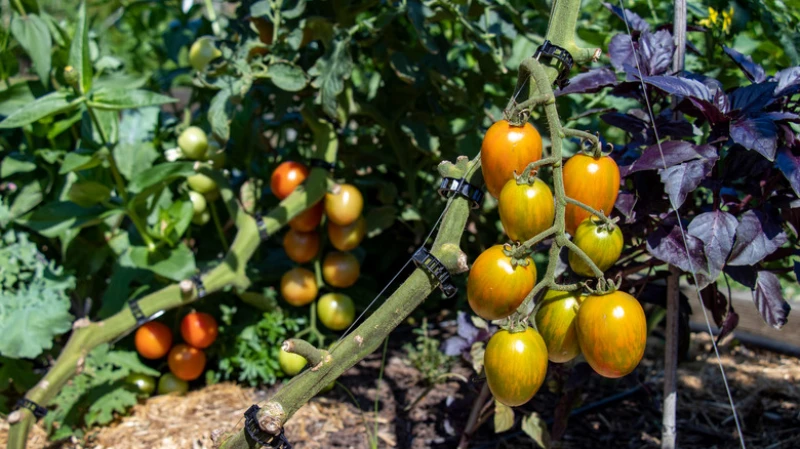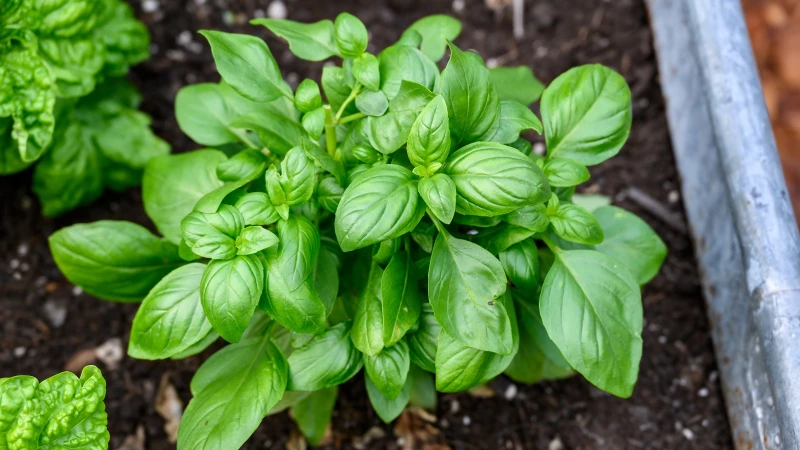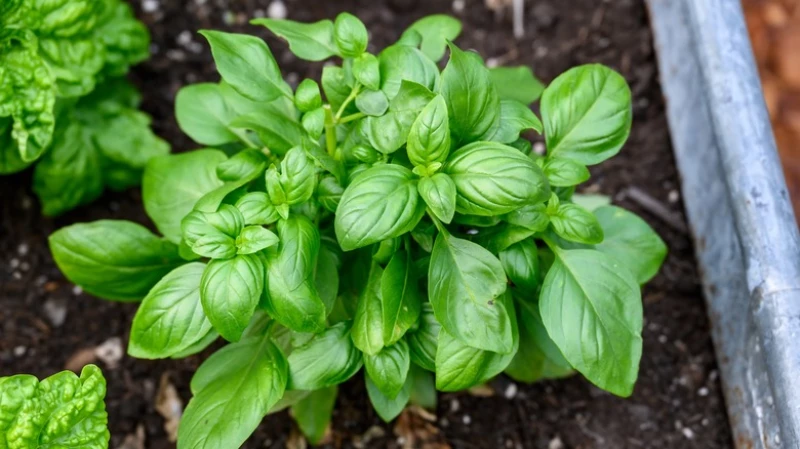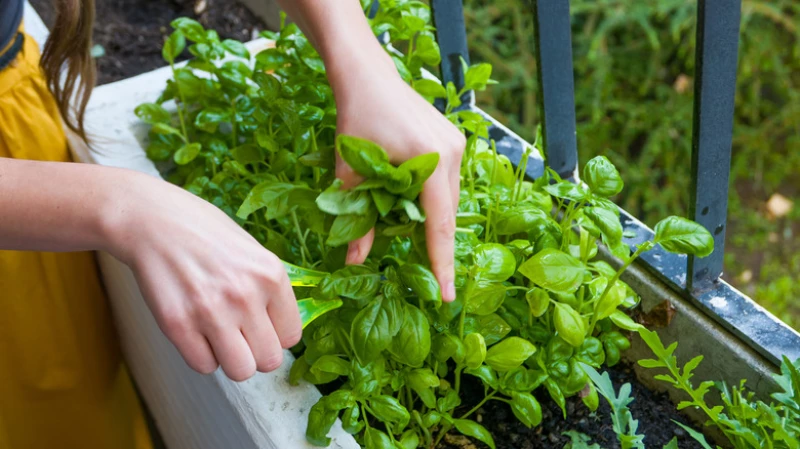If you want to ensure your basil plants thrive and produce flavorful leaves, consider using coffee grounds as a liquid fertilizer. Coffee grounds are rich in nitrogen, which is essential for plant growth. By incorporating this natural fertilizer into your gardening routine, you can help your basil plants reach their full potential.
To use coffee grounds as a liquid fertilizer for your basil plants, simply dilute the grounds in water and apply the mixture to the soil. The nitrogen in the coffee grounds will help promote healthy leaf growth and enhance the flavor of the basil leaves. This simple yet effective gardening hack can make a significant difference in the health and productivity of your basil plants.
Use coffee grounds as a liquid fertilizer
Like most plants, basil benefits from the extra nutrients from fertilizer. However, there's no need to run to your local garden center to purchase fertilizer; the herb will produce a bountiful harvest when given a liquid fertilizer made from coffee grounds. Coffee grounds contain nutrients similar to those of traditional fertilizers, and the grounds also help prevent fungal diseases and pest infestations. The best part is that you can use the wet coffee grounds straight from your coffee pot, reducing waste.
To create homemade fertilizer for your basil, collect 5 gallons of rainwater in a small barrel. Toss in 2 cups of coffee grounds before you go to bed at night. When you wake up in the morning, the brew is ready to feed your plants. You can lightly spray the fertilizer on the plant's leaves and stems or disperse it using a drip irrigation system. Repeat twice per month during the growing season to enjoy a healthy and flourishing crop.
For those with busy schedules or constantly chasing after toddlers, lights with a timer setting for 12 hours can be a game-changer. Simply program the light to turn on and off automatically, allowing you to focus on your daily tasks. Once the light is set up, you can go back to tending to your plants' traditional care needs.
If you want a bountiful harvest, you'll need to begin picking the basil earlier rather than later. Otherwise, the plant switches its energy from providing you with fresh basil leaves to producing new seeds. Pay attention to the temperature and the height of the basil. The Old Farmer's Almanac, in "How to Grow Basil Plants: The Complete Guide," says the plant is ready for harvest when temperatures are around 80 degrees Fahrenheit and the plant has reached a height of around 6 to 8 inches.
Grab a set of kitchen scissors or a small pair of pruning shears and head out to the garden first thing in the morning. Harvest the basil by cutting off the leaves, being sure not to remove more than 20% of the plant at one time. Repeat weekly during the growing season. A healthy plant will produce between 4 and 6 cups of basil each week. If you can't use all of the basil, you can freeze some for later use or give some away to family and friends.
Add tomatoes or marigolds as a companion to basil
When sowing, it's important to consider companion plants that will thrive alongside the basil and provide additional benefits to the crop's success. Regarding basil, both tomato and marigold plants have something to offer. Tomato plants provide basil with shade and moisture retention, while marigolds deter pests that are known to frequent the plant.
Fertilize the soil with liquid seaweed

If you don't have any coffee grinds because you don't regularly drink caffeinated beverages, you can still give your basil some additional nutrients with liquid seaweed. Seaweed provides micronutrients that plants need, and it can be used alongside a fertilizer that meets the plant's traditional nitrogen, phosphorus, and potassium requirements. Rodale Institute describes how to utilize seaweed to increase the fertility of the soil and make the basil better able to resist pests and diseases.
Seaweed is sold in a powder that needs to be mixed with water to create a liquid fertilizer for your basil. You'll find bags are available on Amazon for just under $20. Follow the directions on the packaging to properly mix the seaweed with water, as some manufacturers list ¼ teaspoon per gallon, while others require 1 tablespoon per gallon. Once the liquid fertilizer has been prepared, you can spray it directly on your plant's leaves or onto the soil surrounding the base of your basil plant. This fertilizer works well on both indoor and outdoor plants.
Note: To propagate basil, you can use a glass of water instead of soil. Simply cut a basil stem at a 45-degree angle and place it in a glass of water. Make sure to change the water every few days to prevent bacteria growth. Once roots have grown to about 2 inches, you can transplant the basil into soil for continued growth.
If you want to increase your basil plant yield, consider pruning it to grow new branches. Instead of starting from seeds, you can easily propagate the plant using a glass of water, saving time and effort. This method is beginner-friendly and cost-effective, eliminating the need to purchase new seeds or plants.
To begin, find a healthy basil plant section without flowers and cut it under a leaf node with sterilized scissors. The cutting should be at least 4 inches long, with the bottom 2 inches of leaves removed. Place the cutting in a glass of water in a well-lit area and change the water every few days. Once roots reach 2 inches, transfer them to a pot and continue regular care.
Consider using a root starter for better propagation results, although it's not essential for basil plants.
If you are seeking a bushier basil plant, the key is to practice pruning. Pruning is crucial for maintaining the plant's health and promoting new growth. Allowing flowers to bloom on your basil plant can actually harm the herb's flavor. Before you start pruning, ensure that you have sterilized a pair of kitchen scissors or pruning shears to prevent the introduction of diseases to the plant.
Wait until new plants reach a height of 6 inches and have at least six leaves before you start pruning. Once these criteria are met, use the scissors to trim down to the second set of leaves. Monitor the development of new branches and trim each back to the first set of leaves once they have grown at least six leaves. Whenever you spot a flower, simply pinch it off with your pointer finger and thumb. You can actually eat the flower, so consider adding it to your next salad. After around six weeks, you can transition from pruning to harvesting.
When you buy a pot of basil from the store, you are likely getting multiple basil plants crowded together in one pot, which hinders a bountiful harvest. To increase the yield of your basil plants, it's essential to separate them and plant each individual section in its own pot. By following the tips below, you can ensure that each pot will produce a healthy abundance of basil.
To begin, gently pull the basil plant out of the pot by placing your hand around the stems. The soil will come out along with the plant. Carefully separate each basil section at the roots and transfer them into separate pots. Rennie Orchards recommends specific pot sizes for basil, emphasizing that providing ample space for the basil to grow will result in larger plants. They suggest using a ½-gallon pot for indoor herb keeping and a 2-gallon pot for outdoor herb cultivation.
Remember, if planting basil in the ground outdoors, ensure proper spacing between plants to prevent overcrowding and promote healthy growth.
Basil is a herb that thrives with ample water and moist soil, but not overly wet. Typically, watering basil every three to four days at a depth of 1 ½ inches is ideal, although factors like temperature, wind, and humidity can affect the plant's water needs. Proper watering is crucial for increasing your yield, along with knowing the best watering method for basil plants. Incorrect watering can lead to wilting and make the herb more vulnerable to various fungal diseases.
When watering basil, avoid getting water on the leaves and focus on watering around the base of the plant in the soil. The best time to water your basil plants is in the morning, and always check the soil moisture before watering to prevent overwatering. Water only when the top 2 inches of soil are dry.
Increase sunlight with a reflective mulch
Regardless of the basil variety you're growing, ensuring the herb receives sufficient sunlight is essential. Basil relies on solar energy to thrive by producing necessary nutrients. Placing the plant in a spot that gets full sun is a good start, but using reflective mulch around garden-grown basil can also help redirect sunlight to the plant.
For a successful reflective mulch garden, the first step is to clear out any weeds that may be present. Reflective mulch usually comes in rolls, so you will need to measure and cut a piece to fit the area where you plan to grow your basil. To keep the mulch in place, you can use anchors or simply place rocks or soil over the corners. Then, create planting holes and transplant your basil. Reflective mulch can be purchased online, with prices starting as low as $20. If you're on a tight budget, an alternative option is to use landscaping fabric and paint it with silver spray paint.










